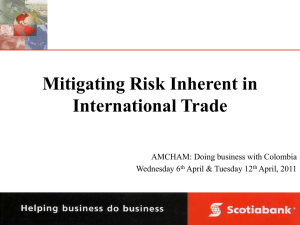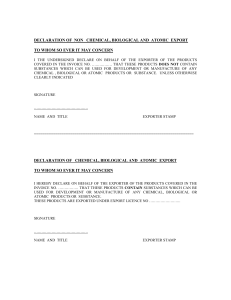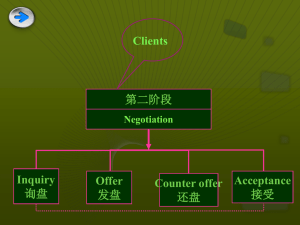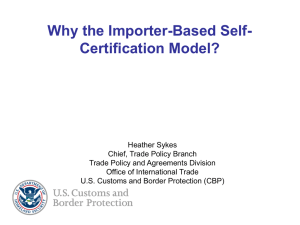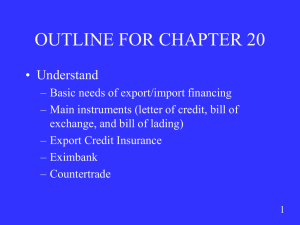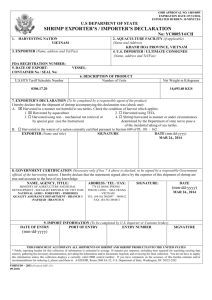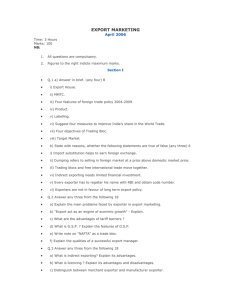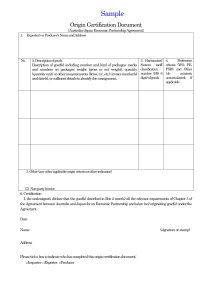Chapter 13 - Financial Management,4th Edition by Suk Kim
advertisement
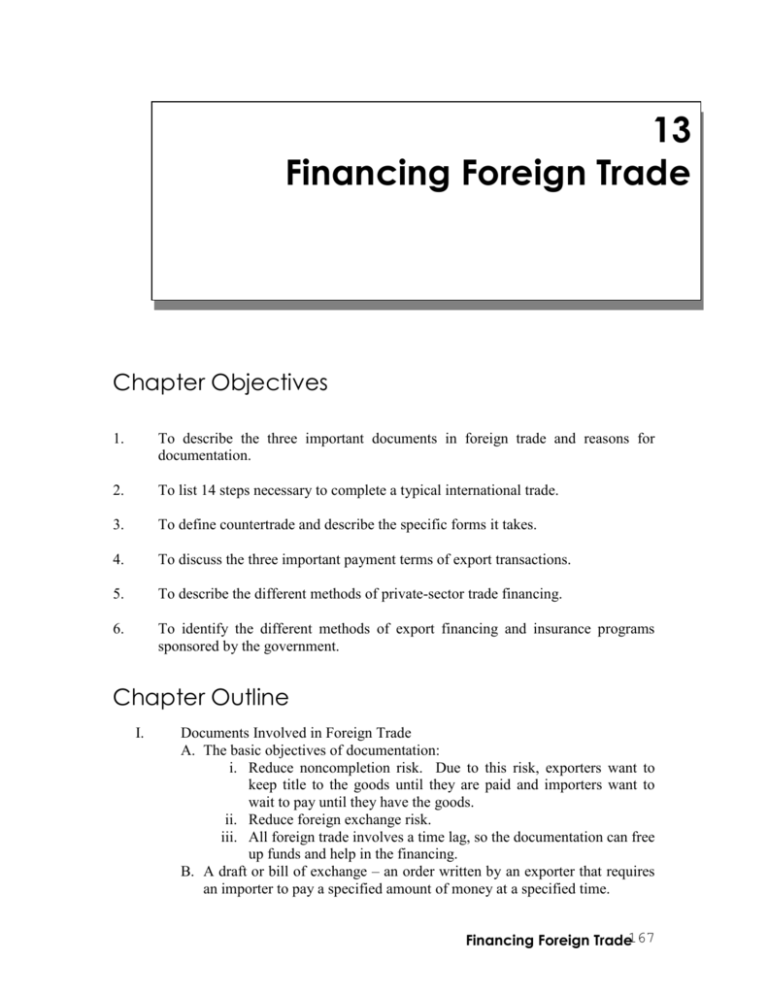
13 Financing Foreign Trade Chapter Objectives 1. To describe the three important documents in foreign trade and reasons for documentation. 2. To list 14 steps necessary to complete a typical international trade. 3. To define countertrade and describe the specific forms it takes. 4. To discuss the three important payment terms of export transactions. 5. To describe the different methods of private-sector trade financing. 6. To identify the different methods of export financing and insurance programs sponsored by the government. Chapter Outline I. Documents Involved in Foreign Trade A. The basic objectives of documentation: i. Reduce noncompletion risk. Due to this risk, exporters want to keep title to the goods until they are paid and importers want to wait to pay until they have the goods. ii. Reduce foreign exchange risk. iii. All foreign trade involves a time lag, so the documentation can free up funds and help in the financing. B. A draft or bill of exchange – an order written by an exporter that requires an importer to pay a specified amount of money at a specified time. Financing Foreign Trade167 i. There are three parties to a draft: 1. The drawer: the person or business issuing the draft. 2. The drawee: the person or business against whom the draft is drawn. 3. The payee: the person or business to whom the drawee will eventually pay the funds. ii. Drafts are only negotiable if they meet four conditions: 1. They must be in writing and signed by the drawer-exporter. 2. They must contain an unconditional promise or order to pay an exact amount of money. 3. They must be payable on sight or at a specified time. 4. They must be made out to order or to bearer. iii. Drafts are used for a number of reasons: 1. They provide written evidence of obligations in a comprehensive form. 2. They allow both the exporter and the importer to reduce the cost of financing and to divide the remaining cost equitably. 3. They are negotiable and unconditional, i.e. drafts are not subject to disputes that may occur between the parties involved. iv. There are two types of drafts: sight (demand) and time (usance). 1. Sight drafts are payable upon demand to the draweeimporter. 2. Time drafts are payable a specified number of days after presentation to the drawee. C. A bill of lading – a shipping document issued to an exporting firm or its bank by a common carrier that transports the goods. i. It serves as a receipt, contract, and document of title. 1. As a receipt, it indicates that the carrier has received the specified goods. 2. As a contract, it is evidence that the carrier is obliged to deliver the goods to the importer in exchange for certain charges. 3. As a document of title, it establishes ownership of the goods. ii. There are different types of bills of lading: 1. Straight bills of lading require that the carrier deliver the goods to the designated party, usually the importer. a. They are used when the goods are paid for in advance, and, thus, are not a title to the goods. 2. Order bills of lading provide that the carrier deliver the goods to the order of the designated party, usually the exporter. a. The exporting firm retains title to the goods until it receives payment. Financing Foreign Trade168 3. On-board bills of lading indicate that the goods have actually been placed on board the vessel. This is important for insurance considerations. 4. Received-for-shipment bills of lading only acknowledge that the carrier has received the goods for shipment. 5. Clean bills of lading suggest that the carrier has received the goods in apparently good condition. 6. Foul bills of lading bear a notation from the carrier that the goods have been damaged before the carrier received them for shipment. D. A letter of credit – a document issued by a bank, at the request of the importer, in which the bank agrees to honor a draft drawn on the importer. i. A letter of credit gives advantages to the exporter: 1. They sell their goods abroad against the promise of a bank rather than a commercial firm meaning that they are almost completely assured of payment. 2. They can obtain funds as soon as they have the necessary documents (the letter of credit and bill of lading). ii. A letter of credit also gives advantages to the importer: 1. It assures them that the exporter will be paid only if he provides certain documents, all of which the bank carefully examines. 2. Recovery of the deposit, in the case of an exporter who is unwilling or unable to make shipment, is easier from the bank than from the exporter. 3. The letter of credit enables the importer to remove commercial risk to the exporter in exchange for other considerations. 4. It is less expensive to finance the goods under a letter of credit than by borrowing. iii. Type of letters of credit: 1. Irrevocable letters of credit can be neither cancelled nor modified without the consent of all parties. 2. Revocable letters of credit can be revoked or modified by the importer’s bank at any time before payment. 3. Confirmed letters of credit are letters of credit confirmed by a bank other than the issuing bank. 4. Unconfirmed letters of credit are a guarantee of only the opening bank. 5. Revolving letters of credit are letters of credit whose duration may revolve weekly or monthly. 6. Non-revolving letters of credit are letters of credit that are issued and valid for a single transaction. E. There are other documents that accompany the draft: Financing Foreign Trade169 i. A commercial invoice is a document issued by the exporter and it contains a precise description of the merchandise (e.g. unit prices, quality, total value, financial terms of sale, and shipping features). 1. Some shipping features are FOB (free on board), FAS (free alongside), C&F (cost and freight), and CIF (cost, insurance, freight). ii. Insurance documents are always used as all shipments of international trade are insured. iii. Consular invoices, document issues by the consulate of the importing country, provide custom officials with information and statistics for the importing nation. iv. Certificates of origin certify the country where the goods are grown or manufactured. v. Weight lists itemize the weight of each item. vi. Packing lists identify the contents of the individual packages. vii. Inspections certificates are issued by an independent inspection company and verify the contents or quality of the shipment. F. A typical trade transaction requires the following 14 steps: i. The Importer places an order for a $1 million worth of machines with an inquiry if the Exporter is willing to ship under a letter of credit. ii. The Exporter agrees to ship under a letter of credit and thus the Importer arranges to have its bank open a letter of credit in favor of the Exporter. iii. The Importer’s bank issues the letter of credit (L/C) in favor of the Exporter and sends it to the Exporter’s bank. iv. Once the Exporter’s bank receives the L/C, it will notify the Exporter. v. The Exporter ships the machines to the Importer through a common carrier that issues an order bill of lading. vi. The Exporter prepares a 60-day draft on the Importer in accordance with the L/C and presents it to the Exporter’s bank along with such other documents as billing a lading. At the same time, the Exporter endorses the order bill of lading so that a title to the machines goes with the holder of the documents. vii. The Exporter’s bank forwards the draft and other documents to the Importer’s bank for acceptance. When the draft is accepted by the Importer’s bank, it becomes a banker’s acceptance (B/A). This means that the Importer’s bank has promised to pay the draft in 60 days. viii. The Exporter instructs its bank to have the B/A discounted by the Importer’s bank. Alternatively, the Exporter’s bank receives the B/A from the Importer’s bank and then it may sell the B/A to an investor at a discount. Another alternative is that the Exporter’s bank may hold the B/A for 60 days and present it to the Importer’s bank for payment. Financing Foreign Trade170 ix. If the Exporter’s bank has discounted the B/A with the Importer’s bank, it transfers the proceeds less any fees and discount to the Exporter. x. The Importer’s bank notifies the arrival of the documents to the Importer. The Importer signs a promissory note to pay its bank for the machines in 60 days. xi. Then the Importer’s bank releases the shipping documents so that the Importer can claim the shipment. xii. Then the Importer’s bank may sell the B/A/ in the money market to an investor. xiii. In 60 days, the Importer’s bank receives the funds from the Importer to cover the maturing B/A. xiv. On the same day, the holder of the B/A presents it to the Importer’s bank for payment. Or, the holder of the B/A may return it to the Exporter’s bank for collection through normal banking channels. II. Payment Terms of Export Transactions A. Countertrade refers to various international trade arrangements in which the sale of goods and services by an exporter is linked to an import purchase of other goods or services. i. There are no reliable figures because so much secrecy is involved, but it is estimated that countertrade accounted a third of all world trade in 2000. ii. There are many different types of countertrade: 1. Simple barter is a direct exchange of goods between two parties without the use of any currency as a medium of exchange. 2. A clearing arrangement is a form of barter in which any two countries agree to buy a certain amount of goods and services from one another within a given period of time. a. Both parties set up clearing account with each other that are debited whenever one country imports from the other. b. At the end of an agreed-upon amount of time, any account imbalances are cleared by a hard currency payment or by additional transfer of goods. 3. A switch trade is a trading arrangement under which a third party purchases any account imbalance between the two countries. a. The basic purpose is to eliminate the imbalance in barter trade between two countries. 4. A counterpurchase, also known as an indirect offset, involves a standard hard currency export, but the seller agrees to a return purchase of goods and services not directly related to the goods that the seller sold. Financing Foreign Trade171 a. This form of countertrade typically takes place between a Western industrial country and a Third World country. 5. A compensation agreement is an agreement by an exporter of plant and/or equipment to receive compensation in the form of future output from that plant. a. These transactions typically involve large expenditures and a long-term time frame for fulfillment, and, thus, are an alternative form of direct investment. 6. An offset agreement, also known as a direct offset, is an arrangement where the seller is required to use goods and services from the buyer country in the final product. a. The most common categories of offsets are coproduction, licensed production, subcontractor production, oversea investment, and technology transfer. iii. There are a variety of reasons for the growth of countertrade: 1. Limited access to hard-currency finances. 2. Opening of new markets 3. Use of countertrade as an alternative to direct investment. 4. Avoidance of trade restrictions. 5. Fulfillment of state planning goals. 6. Disposal of surplus and poor quality goods. B. Cash Terms i. COD terms mean cash on delivery of goods. ii. CBD terms mean cash before delivery of goods. 1. Under either term, the exporter does not extend credit. 2. COD terms have a risk that an importer may refuse a shipment. 3. CBD terms have no risk. iii. Cash terms are the exception in modern trade. 1. Importers do not like cash terms because they accept all risk in transit, in exchange rate fluctuations, and in the quality of the goods received. C. A consignment is the delivery of goods into the possession of another for the purpose of sale. i. The exporter pays all shipping expenses, but maintains the goods in its inventory until the time of delivery. ii. There is high risk in this type of transaction, so usually only companies with high levels of trust use it. D. Credit Terms i. Exporters extend credit to the importer to allow them a short postponement period before payment is made. Financing Foreign Trade172 ii. Open account credit does not require the importer to sign a formal debt instrument as evidence to the amount that she owes the exporter. Instead, the importer simply charges her purchases. 1. The entire financial burden is on the exporter. iii. Promissory notes are a document signed by the importers that evidences her debt to the exporter. 1. The note calls for payment at some future date. iv. A trade acceptance is a form of short-term financing where the exporter draws a draft on the importer ordering her to pay the draft at some specified future date, and the exporter will not release the goods until the importer accepts the draft. 1. This is the most common form of short-term financing for foreign trade activities. v. The cost of the cash discount foregone refers to the period of time allowed for payment. 1. “net 30” means that the invoice must be paid within 30 days. 2. “2/10, net 30” means there is a 2 percent discount if payment is made within 10 days, if not the full amount must be paid within 30 days. E. Collecting overdue accounts: i. Normally, 1 to 3 percent of a company’s exports go uncollected. 1. Small exporters tend to take more risk than larger ones because they are eager to develop a new market opportunity, often sell on terms other than a confirmed letter of credit, and they are not as well versed with the mechanics of foreign sales. ii. To establish a procedure for past-due account, the exporter must decide how overdue an account can be before collection procedures are started. 1. If they are begun to early, they will be too expensive. 2. If they are begun to late, they will be more difficult to collect. III. Sources of Financing Foreign Trade A. Banks, private financing, and governments all finance foreign trade. B. Bank Financing: i. A trust receipt established that borrowers hold certain goods in trust for the lender. The bank retains title to the goods until the importer has made full settlement. ii. Banker’s acceptances are drafts accepted by banks and are a form of a bank loan to exporters. 1. They have to be of a very high quality. iii. Banks can also make loans to exporters by chasing, purchasing, discounting, and collecting drafts. C. Private Financing: Financing Foreign Trade173 i. The Export Trading Company Act of 1982 was designed to remove barriers to U.S. exporter success: 1. It allowed bank holding companies to invest in export trading companies. 2. It permitted competing companies to join for export purposes without fear of antitrust ramifications. ii. Export trading companies engage in two forms of activity: 1. Acting as trade intermediaries, that is providing small and medium-size firms with one-step services such as market analysis, distribution services, documentation, financing, foreign exchange transactions, transportation, and legal assistance. 2. Acting as export outlets, that is buying products from other U.S. companies and exporting these products. iii. Factors buy a company’s accounts receivable largely on a nonrecourse basis and thus accelerate the conversion of the company’s claims against its customers. 1. Nonrecourse means that the factor has no right to claim reimbursement from the seller of account receivable if the seller’s customers fail to pay their bills. 2. Factors also do credit checking, bookkeeping, account collecting, and risk bearing. 3. Factors rates on foreign accounts are usually higher than those of banks and are therefore seen as a last resort by exporters who need funds badly and/or who have no hope for collecting. 4. In June 1999, it was reported that 700 factors from 50 countries financed $500 billion worth of exports in 1998. iv. A forfaiting transaction refers to the purchase of financial obligations, such as promissory notes, without recourse to the exporter. 1. Forfaiting markets, centered in London and Zurich, are largely free of government support, supervision, or regulation. 2. There are four parties in a forfaiting transaction: a. The importer who pays the exporter with promissory notes that will mature at set intervals over a several-year period. b. A bank in the importer’s country that guarantees these promissory notes making them irrevocable, unconditional, and transferable. c. The exporter who in turn sells the guaranteed paper to the forfaiter at a discount from the face value. i. The discount size depends on the importer’s credit rating, the guaranteeing banks’ Financing Foreign Trade174 credibility, and interest costs over the paper’s lifetime. d. A forfaiter who buys the paper and as it matures, present it to the guaranteeing bank for payment. 3. Forfaiting allows the exporter to avoid most risks, but it still has drawbacks: a. The amount of the discount can be large. b. The guaranteeing bank normally charges a substantial fee and places a freeze of equal value on the importer’s account. c. The exporter still faces some risk if the bank guarantor and/or the importer refuse to pay on the ground that the notes have some hidden legal defect. D. Export Financing Methods in Practice i. A survey was completed in 1995 of Fortune 200 export-financing methods. 1. Open accounts and letters of credit are the most frequently used methods. 2. U.S. companies appear to increase their export sales by offering attractive terms to foreign customers. 3. About half of the respondents reported that they sometimes used drafts and cash in advance. E. Government Financing i. The Export-Import Bank (Exim Bank) was founded in 1934 as an independent agency of the U.S. government focused on promoting U.S. exports through a variety of export financing and loan guarantees. 1. The Foreign Credit Insurance Association (FCIA) was created in 1963 to add insurance to already provided services of loan and guarantee. a. The Exim Bank took over the FCIA in 1983. 2. Exim Bank operations conform to two general guidelines: a. Loans must be used exclusively to finance the export of goods and services of U.S. origin. b. Loans should have reasonable assurance of repayment and related transactions should not adversely affect the U.S. economy. ii. The Private Export Funding Corporation (PEFCO) was created in 1970 with the purpose to mobilize private capital in order to finance U.S. exports of big tickets items such as aircraft and power plants. 1. PEFCO’s stockholders consist of 54 commercial banks, seven large manufacturers, and one investment banker. 2. All of PEFCO’s loans are guaranteed by the Exim Bank and are general obligations to the United States. Financing Foreign Trade175 Key Terms and Concepts Draft or a bill of exchange is an order written by an exporter that requires an importer to pay a specified amount of money at a specified time. Drawer is a person or business issuing a draft. Drawee is a person or business against whom the draft is drawn. Payee is a person or business to whom the drawee will eventually pay the funds. Bill of Lading is a shipping document issued to an exporting firm or its bank by a common courier that transports the goods. Letter of Credit is a document issued by a bank at the request of an importer. Commercial Invoice is issued by the exporter; it contains a precise description of the merchandise, such as unit prices, quality, total value, financial terms of sale, and shipping features. Consular Invoice provides customs officials with information and statistics for the importing nation. Countertrade refers to the world trade arrangements that are variations on the idea of a barter. Simple Barter is a direct exchange of goods between two parties without the use of any currency as a medium of exchange. Clearing Arrangement is a form of barter in which any two countries agree to buy a certain amount of goods and services from one another within a given period of time. Switch Trade is a trading arrangement under which a third party purchases any account imbalance between the two countries. Counterpurchase, also known as "indirect offset", involves a standard hard-currency export, but the seller agrees to a return purchase of goods and services that are not directly related to the goods that the seller sold. Compensation (Buy-Back) Agreement is an agreement by an exporter of plant and/or equipment to receive compensation in the form of future output from that plant. Financing Foreign Trade176 Offset Agreement, frequently called "direct offset" is an arrangement similar to the counterpurchase, but the seller is required to use goods and services from the buyer country in the final product. Consignment is the delivery of goods into the possession of another for the purpose of sale. Open Account credit does not require the importer to sign a formal debt instrument as evidence to the amount that she owes the exporter, but the importer simply charges her purchases, much in the same way that domestic retail stores extend credit to their customers. Promissory Notes are notes that the importer is requested to sign as evidence of her debt to the exporter. Trade Acceptance is a draft accepted by an importer or a business enterprise. Trust Receipt establishes that borrowers hold certain goods in trust for the lender. Bankers Acceptances are drafts accepted by banks. Export-Trading Company Act is a law that President Reagan signed in October 1982 to help small-and medium-size companies sell their goods overseas. Factors buy a company's accounts receivable on nonrecourse basis and thus accelerate the conversion of the company's claims against its customers. Forfaiting transaction involves an importer that issues a promissory note to pay for the imported goods over a period of three to five years. Export-Import Bank (Exim Bank) was founded in 1934 as an independent agency of the U.S. government to promote U.S. exports through a variety of financing and loan guarantees. Private Export Funding Corporation (PEFC) was created in 1970 at the initiation of the Bankers' Association for Foreign Trade with the support of the U.S. Treasury Department and the U.S. Exim Bank to mobilize private capital for financing U.S. exports of big ticket items. Foreign Credit Insurance Association (FCIA) was organized in the Fall of 1961 by the Secretary of Treasury, the Exim Bank and 50 leading insurance companies to provide protections for U.S. exporters. Multiple Choice Questions Financing Foreign Trade177 1. Which of the following is not a basic objective of documentation in foreign trade? A. to assure that the exporter will receive the payment B. to assure that the importer will receive the goods C. to eliminate risk of noncompletion D. to reduce foreign exchange risk E. none of the above 2. Which of the following is not an important document in foreign trade? A. a check for the value of goods B. a draft C. bill of lading D. a letter of credit E. none of the above 3. ______ risk is the potential exchange loss from outstanding obligations as a result of exchange-rate fluctuations. A. Trade B. Exchange C. Finance D. Noncompletion E. Transaction 4. Foreign exchange risk can be reduced by using _____. A. forward contracts B. futures contracts C. currency options D. currency denomination E. all of the above 5. Which of the following is not a condition for drafts to be negotiable? A. must be in writing, signed by the drawer B. must contain a promise to pay a certain sum if goods are received C. must contain an order to pay D. must be payable on sight or at a specified date E. must be made out to order or bearer 6. If a draft is made to bearer, payment should be made to _____. A. a bank B. drawer C. acceptor D. anyone who presents the draft E. all of the above 7. If a draft is accepted by a bank, it becomes a _____. A. valid draft B. demand draft Financing Foreign Trade178 C. usance draft D. banker's acceptance E. drawee's acceptance 8. Forms of countertrade include the following except ___. A. simple barter B. clearing arrangement C. switch trade D. counterpurchase E. mutual agreement 9. Documentary drafts require various shipping documents such as ____. A. bills of lading B. insurance certificates C. commercial invoices D. A and B E. A, B, and C 10. When IBM ships products to its subsidiary in Argentina, it will most likely use a ____ draft. A. sight B. clean C. D/P D. demand E. all of the above 11. If a carrier is instructed to deliver goods to an importer, a _____ bill of lading is used. A. straight B. order C. documentary D. on-board E. clean 12. A(n) _____ bill of lading does not guarantee that the goods have been loaded on the vessel. A. on-board B. foul C. received-for-shipment D. straight E. order 13. Which of the following is not true of a letter of credit? A. it is a document B. issued by a bank C. at the request of the exporter D. the bank agrees to honor a draft drawn on the importer Financing Foreign Trade179 E. payable in the designated currency 14. If a letter of credit can be neither cancelled nor modified without the consent of all parties, it is known as _____. A. revolving B. irrevocable C. revocable D. unconfirmed E. unclean 15. If an exporter is doubtful about an issuing bank's ability to pay, he will expect a domestic bank to join the transaction in a _____ letter of credit. A. revolving B. irrevocable C. revocable D. unconfirmed E. confirmed 16. Which of the following may be required as additional documents in a letter of credit? A. commercial invoice B. insurance document C. consular invoice D. certificate of origin E. all of the above 17. Which of the following documents should necessarily accompany a draft? A. certificate of origin B. weight list C. packing list D. inspection certificate E. none of the above 18. A commercial invoice is issued by _____. A. exporter B. exporter's bank C. importer D. importer's bank E. confirming bank 19. A document that contains a precise description of the goods is known as a _____. A. weight list B. packing list C. commercial invoice D. certificate of origin E. consular invoice Financing Foreign Trade180 20. Which of the following is not true of a consular invoice? A. provides customs officials with all information B. facilitates easy customs clearance C. helps customs officials assess duties D. issued by the consulate of the exporting country E. it is not a title to the goods 21. Which of the following is not a form of offset agreements? A. coproduction B. licensed production C. subcontractor production D. cash in advance E. technology transfer 22. Which of the following is not a form of countertrade? A. barter B. consignment C. switch trading D. counterpurchase E. compensation agreement 23. In a _____ countertrade the initial seller receives compensation in products that arise out of the original sale. A. consignment B. barter C. counterpurchase D. buy-back agreement E. switch trading 24. Buying a company's accounts receivable on a nonrecourse basis is known as _____. A. switch trading B. financing C. factoring D. funding E. free trade 25. Which of the following is not necessarily a party to a forfaiting transaction? A. exporter B. importer C. broker D. bank E. forfaiter 26. Below are five steps involved in a typical trade transaction. Which step is out of order: A. exporter agrees to ship under a letter of credit Financing Foreign Trade181 B. exporter ships the product to the importer C. importer’s bank issues the letter of credit D. exporter prepares a 60-day draft on importer in accordance with the letter of credit. E. the draft is accepted by the importer’s bank becoming a bankers’ acceptance. 27. The “three C’s” of international commerce are: A. customers B. commitment C. currency D. cultural sensitivity E. A, B, and D 28. When exporting some common pitfalls include: A. failure to use an export management company B. failure to print service, sales, and warranty messages in local languages C. chasing orders around the world instead of establishing a basis for profitable operations and orderly growth D. failure to consider licensing or joint venture agreements E. all of the above Answers Multiple Choice Questions 1. E 2. A 3. E 4. E 5. B 6. D 7. D 8. E 9. E 10. B 11. A 12. C 13. C 14. B 15. E 16. E 17. E 18. A 19. C 20. D 21. D 22. B 23. D 24. C 25. C 26. C 27. E 28. E Financing Foreign Trade182
